Manchester City travelled to Goodison Park to play Everton in a must-win fixture for them to ensure they close the gap between them and the Premier League leaders, Liverpool. A win over Everton would put them five points behind Liverpool after suffering a defeat to Norwich and a draw against Tottenham so far in the English Premier League. Everton themselves needed their three points after losing consecutive games against Bournemouth and Sheffield United. They would require some optimism though, as Manchester City would be the toughest opponents they would face this season along with their rival neighbours, Liverpool.
Nevertheless, Everton’s tactics did manage to frustrate City during multiple phases of this game. By exploiting their aerial abilities and set-piece successes Everton elicited a heroic performance from City’s keeper Ederson Moraes to keep the hosts at bay. It was an absolute sugar rush for 90 minutes at Goodison Park as the toffees took on the Manchester side in their candy-coloured kits. In this tactical analysis, we examine deeper how both teams faced each other.
Lineups
Marco Silva’s side lined up in a 1-4-4-1-1 with a backline of Séamus Coleman, Michael Keane, and ex-Barca boys Yerry Mina and Lucas Digne. In front of them operated the double pivot of Morgan Schneiderlin and Manchester City’s former veteran Fabian Delph in midfield. Theo Walcott had to be substituted early due to a head injury by Alex Iwobi newly arrived from Arsenal. Along with Richarlison on the wing, the forwards Gylfi Sigurðsson and Dominic Calvert-Lewin worked up top.
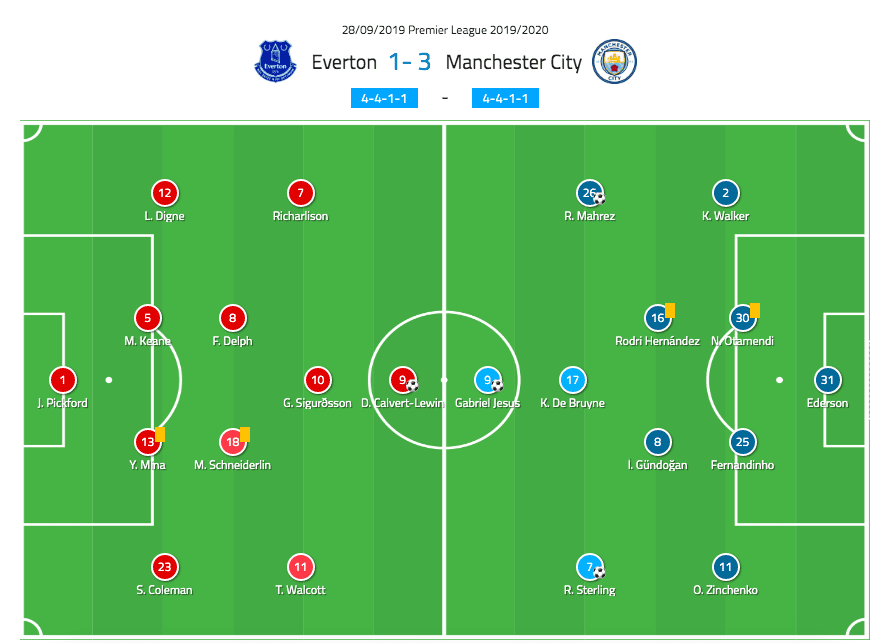
Manchester City were looking ahead to a busy week with the Champions League fixture against Dinamo Zagreb coming up. It must have been a challenge to periodise the training and keep all the players in shape while ensuring that they take three points in Liverpool. Given the fact that John Stones is still injured and Aymeric Laporte is out, Pep Guardiola opted for Fernandinho and Nicolás Otamendi as the centre-half pair, after running riot against Watford. Alongside, Oleksandr Zinchenko and Kyle Walker operated as fullbacks. Rodri played the single-pivot with İlkay Gündoğan and Kevin De Bruyne playing more advanced roles in the midfield. Gabriel Jesus was chosen as the lone striker with Raheem Sterling and Riyad Mahrez on the wings.
Tactical face-off
We expected Man City to dominate possession and play the game in Everton’s half creating most of their chances with the deep balls to release the pace of Sterling and Mahrez. Everton would look to break quickly upon turnover of possession and hit City on the counter-attack. However in this game, at least for the first half, City had an expected goals (xG) figure of 1.84 which was one of their lower figures in the league. How did Everton manage this? We shall look deeper in this analysis.
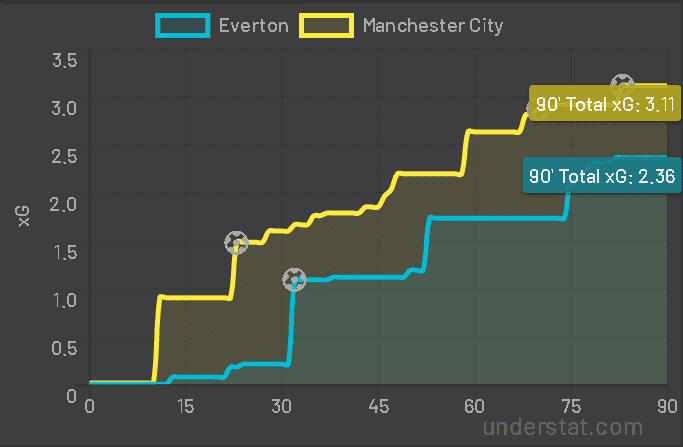
Firstly Everton exploited the shorter pitch length of their home ground. At 100×68 sq. metres, the Goodison Park is easily five metres shorter than the Etihad and most other pitches in the Premier League. This meant, even if City pinned Everton back into their own half, they would struggle to find the depth for the penetrating balls if Everton stayed compact in the defence. Hence City would have to resort to diagonal balls to their wingers. The shorter pitch length also favours fast breaks on counters which Everton looked to exploit.
City’s big weakness was their defence. Fernandinho, a holding midfielder was filling in for a role he wasn’t naturally made for. Otamendi has had a record of errors against Norwich City. Zinchenko and Walker, although effective players in building up attacks for City are not highly rated for their defensive attributes. Everton looked to exploit this circumstance by isolating the defenders with early runs in behind from their forwards. Everton have also a high statistic of chances created from corner kicks this season which they put to full use against City.
City’s attacking strategy
Guardiola set up City in a 4-2-3-1 but the formation was very fluid and positional in the attacking organisation. Fernandinho was the focus of initiating the buildup alongside Otamendi and they would patiently look to find players behind opposition lines of pressure. Gündoğan, Jesus and De Bryune would position themselves between the defensive line and pin the back four of Everton. Walker and Zinchenko would drift inside as inverted fullbacks. Sterling and Mahrez stretched the width of the pitch and provided 2v1 scenarios against the opposition fullbacks during attack.
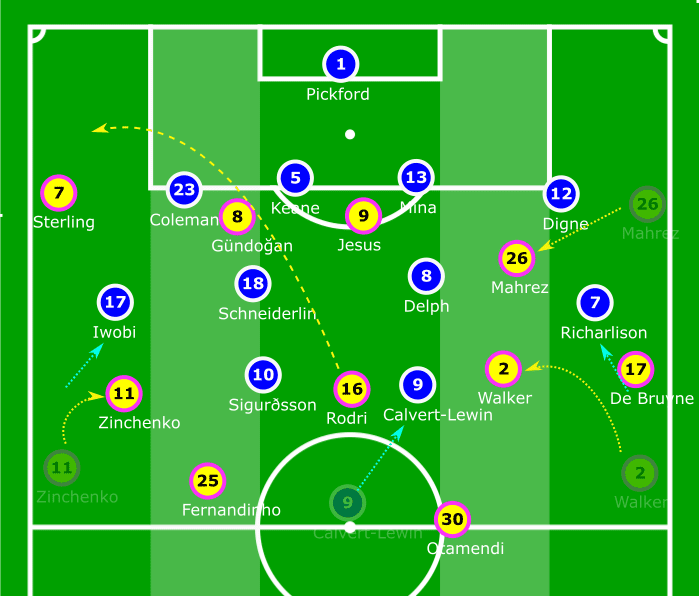
On the right side, Mahrez and De Bruyne would indulge in plenty of positional rotations depending on the situation in order to draw their markers out of position and create space for their teammates to run into and receive the ball between the lines. The centre forward Jesus (and later Agüero) would drop deep as a false-nine to add to the numerical superiority in the centre and thread passes through the lines of pressure.
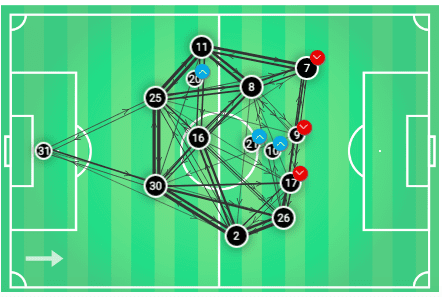
Marco Silva set up Everton in a 4-4-2 unit when out of possession to counter City’s attacks. Calvert-Lewin would drop from an advanced position alongside Sigurdsson in order to close the passing lanes to Rodri. Delph helped out defensively in marking De Bruyne as Digne was engaged in dealing with threats from the wide areas from Mahrez.
Seeking Sterling
City’s game model is designed to create overloads using numerical superiority on one side of the pitch and use short and quick passing to attract the pressure. Once they shift their markers out of position in this way, they look for the free player on the opposite side of the pitch to quickly take advantage of the spaces that open up in their opposition’s shape.
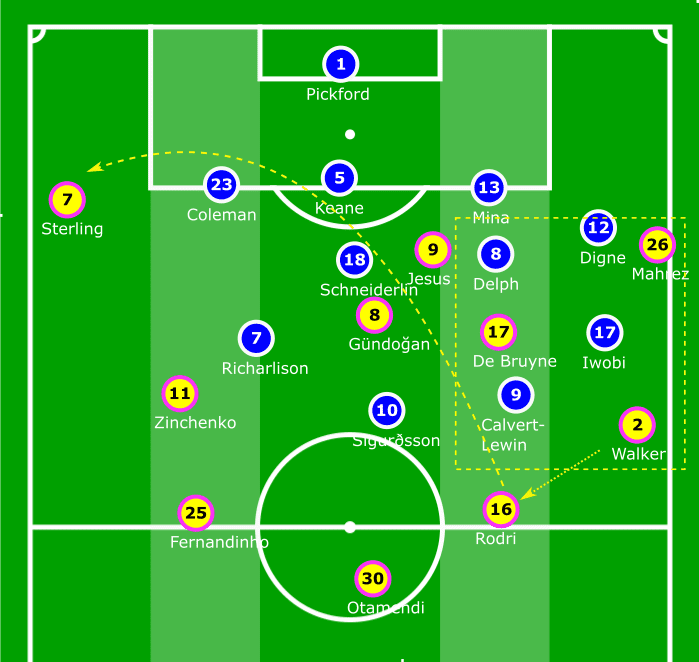
We saw a lot of this movement in an attempt to find Sterling on the left-wing. In fact, close to half of City’s attacks came from the left after a switch of play with a diagonal long pass to Sterling. Although a similar approach was used to find Mahrez on the other flank, it was Sterling who was the target of most of the attack as Mahrez was tasked to help out more defensively in this game.
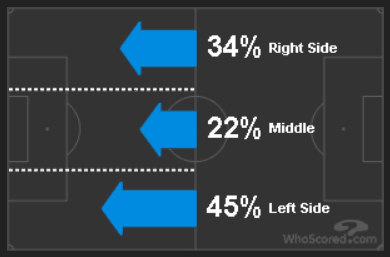
Although the tactic itself was successful as Sterling was able to receive the able without much trouble multiple times, he could not create a lot of threat by himself. During the game, he only managed one successful dribble out of five attempted dribbles, which shows Coleman and Keane were quite efficient in defending against him, especially in the first half. City’s strategy to capitalise on Sterling’s incredible form to score early for the visitors wasn’t bearing fruit until later on in the game.
After half hour of play, Guardiola instructed Sterling to interchange positions with Jesus with Sterling making runs between the central defenders and Jesus drifting out wide. During the second half, Sterling was able to score the final goal for City with a build-up that began on the left but shifted to the right to Mahrez who put the ball back into Sterling’s path to score.
The function of inverted full-backs
We are already familiar with Guardiola’s use of inverted fullbacks for two seasons at City. But the tactic of using fullbacks who tuck in alongside the midfielders and help in attack has a purpose and is used in specific situations.
In this game, we saw Everton’s strikers hold a deeper position when out of possession to block the passing lanes to Rodri, the deep-lying playmaker who uses intelligent positioning to distribute the play and play dangerous passes for City to penetrate the opposition’s spaces. Everton were quite successful in neutralising Rodri in this game using Calvert-Lewin and Sigurdsson as Rodri only had 73 touches out of the total of 813 touches that City had during this game – less than Zinchenko and Gündoğan.
For this reason, it was necessary for Walker and Zinchenko to drift in alongside Rodri in the middle in order to balance out the numerical superiority that Everton looked to gain in the centre. By having an extra man in the middle, City could easily form triangles in passing to attract pressure and then distribute the ball out wide. Having Walker and Zinchenko often fill in the hole that Rodri operated, Rodri was able to drop freely in the defensive line between Fernandinho and Otamendo or alongside them to form a back-three. With this movement, City often built up with a 3-2-5 structure.
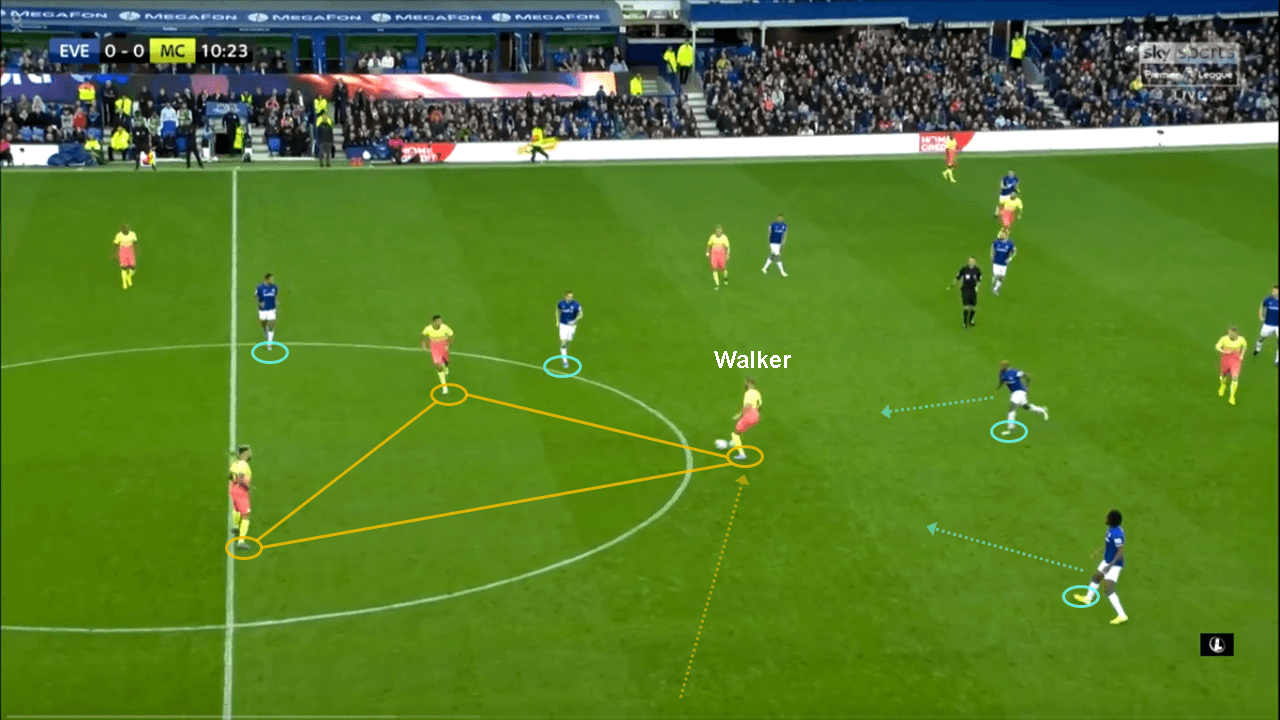
The advanced players, Mahrez and De Bruyne would also drop into the centre, between the lines for the same purpose of matching the numerical superiority of the Everton players. Jesus dropping deep would be the trigger for the immediate switch to Sterling and the cue for De Bruyne or Mahrez to make runs in behind the Everton defence. In this way City looked to threaten the Everton back-line.
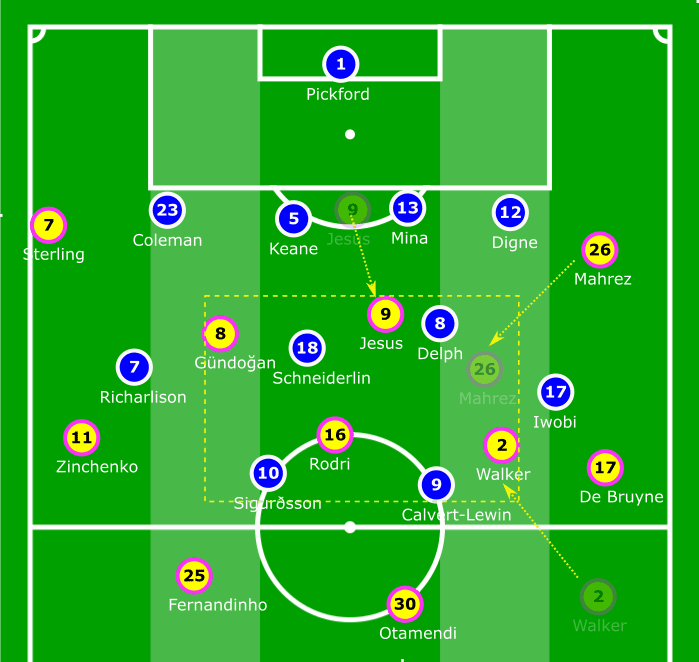
The first goal for City came as a result of a De Bruyne following back unmarked and putting an early cross, first touch to find Jesus who headed it past Jordan Pickford. We have seen De Bruyne provide multiple assists in a similar fashion. We know that third-man runs are very difficult to defend against, and De Bryune’s first touch curling crosses from a lay off can be considered a third-man run from an attacker on the opposite side which catches defenders off-guard.
Everton’s attacking organisation
Everton managed to equalise within 15 minutes of City taking the lead. One of the key reasons was City’s initial defensive organisation strategy. Normally, Guardiola’s system enforces a high-pressing tactic to win the ball upon giving away possession as the higher up the pitch the ball is won, the more easy it is to rebuild the attack. But in this game, considering the weaknesses in City’s defensive line, they opted to contain rather than press high and focused on getting numbers behind the ball upon losing possession. Once secure, they pressed in a 4-4-2 structure with De Bruyne having more freedom up alongside Jesus to press higher.
This wasn’t a game where Everton would look to match City in terms of passes completed. But for around 25 minutes from the 20-minute mark until the end of the first half, we saw Everton enjoying a lot of possession in the attacking phase and pinning City back in their half. For some reason, Man City players stepped off the gas after Jesus’ goal and sat too deep allowing Everton to complete 54 of the 124 passes they managed in the final third during this game. City allowed 9.71 passes per defensive action (PPDA) which is quite high considering how much City enjoy keeping possession.
In the attack, Iwobi would drift into central spaces allowing Digne to use his pace and stretch the width on the left flank. On the other side, Richarlison would stay wide on the right, while Coleman would drift into spaces inside during build-up, similar to Walker. Schneiderlin operated between the lines of pressure in the midfield quite successfully for Everton in the right half-spaces and 20 out of his 33 passes were forward passes to create attacking opportunities. The forwards Calvert-Lewin and Sigurdsson were very alert to make early runs in behind the defence and attack any second-ball or rebounds.
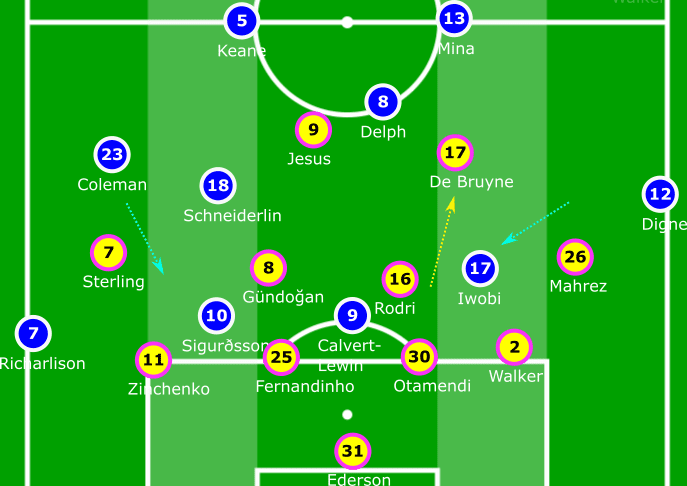
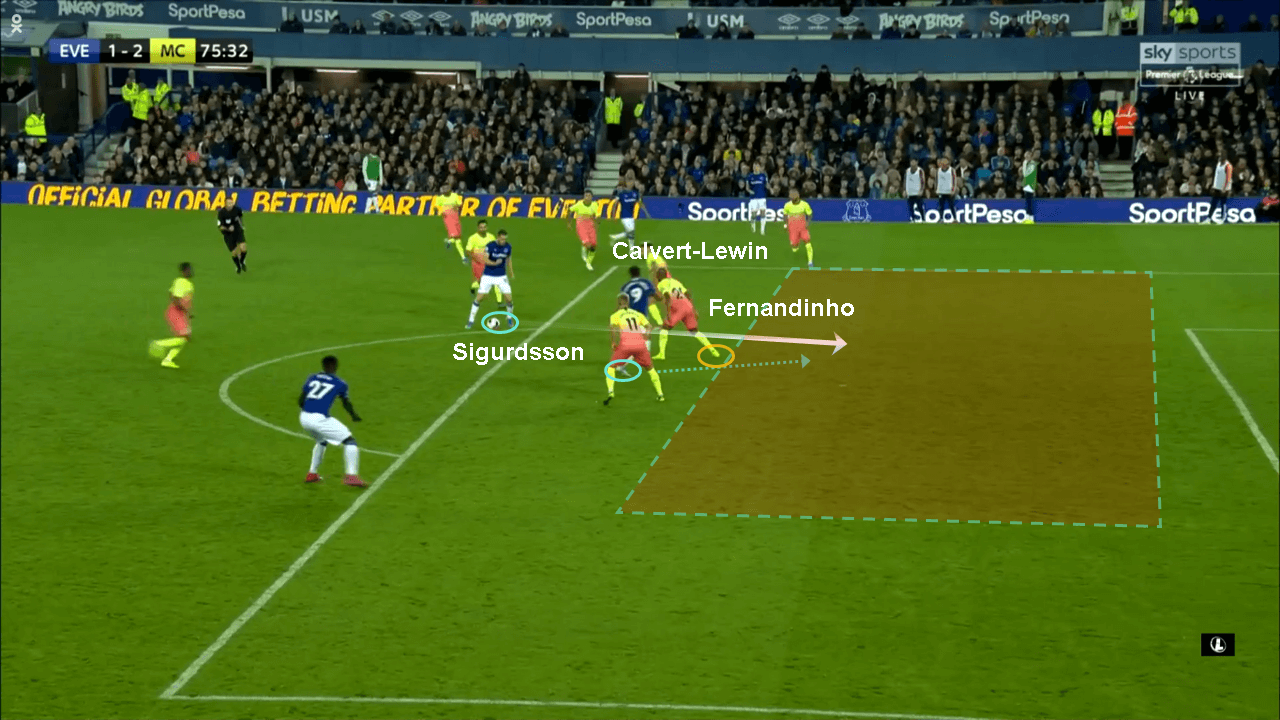
The equalising goal for Everton came in this manner with Coleman sneaking in behind Fernandinho as Richarlison stayed wide and kept Zinchenko pinned. Iwobi created plenty of playmaking from central areas and managed to find Coleman unmarked who was quick to attack the space in behind. Calvert-Lewin followed up immediately with both combining to score for Everton.
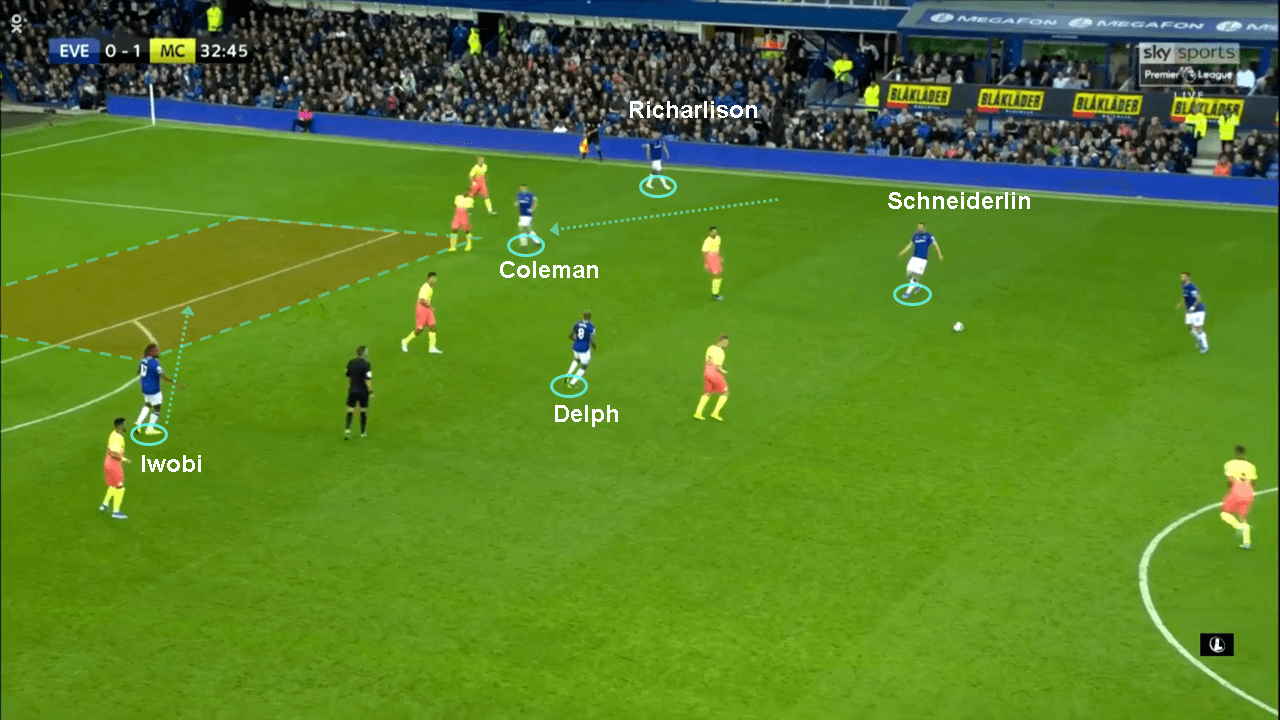
Considering how much Iwobi was a menace for City as a playmaker on the left frequently inverting into central areas, we can be incredulous if this was really part of Marco Silva’s strategy. Iwobi came early on to fill in for an injured Theo Walcott and the substitute was substituted off in the 72nd minute for Moise Keane.
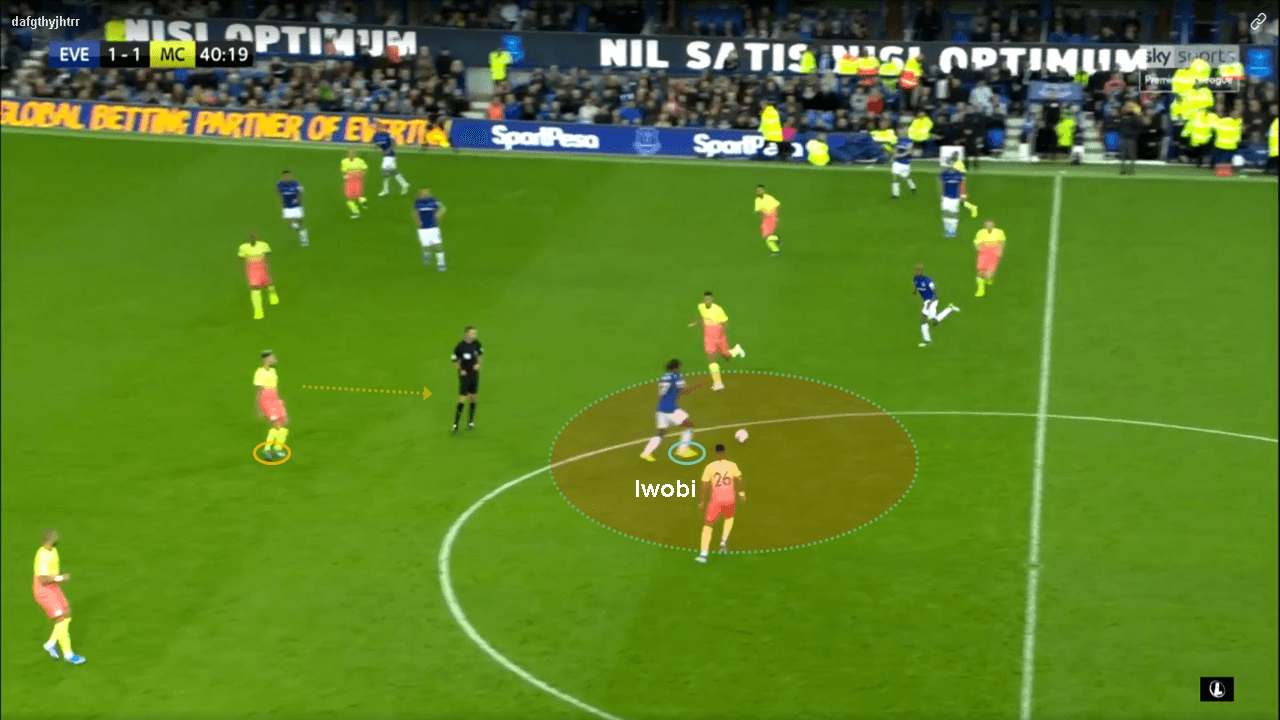
Everton’s aerial dominance
Everton were the better side when it came to winning aerial duels. They won 16 aerial challenges in comparison to 11 won by City. The interesting bit of this statistic is not just the number but the locations where these aerials were won. If we see a plot of the aerials won during the game, we see many of them won in City’s half. So we can see that these were not purely defensive headers won by Everton.
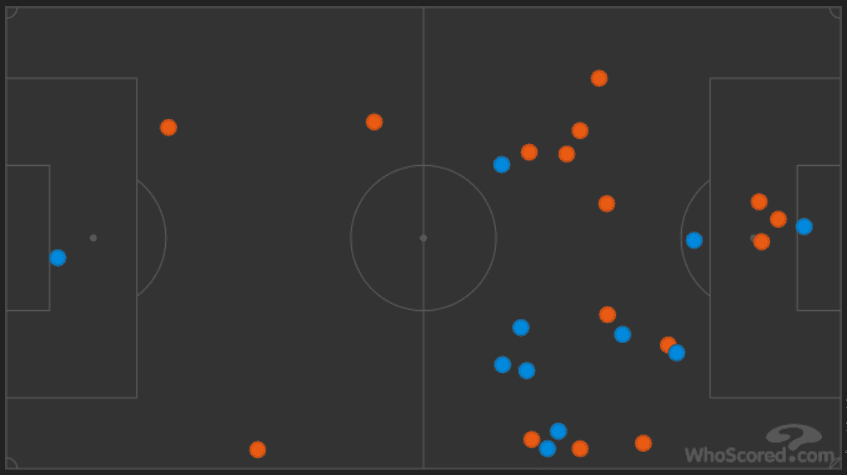
Everton were also far more superior to City in corner kicks with Yerry Mina winning three open headers and registering three shots on target. On any other day they could have easily resulted in goals but it was Ederson with some heroic saves that helped keep these headers out of City’s net.
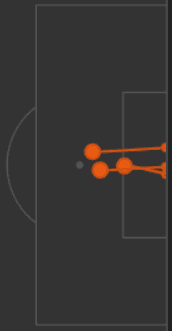
The strategy with the long balls from the back played out to the forwards was to have Iwobi, Sigurdsson and Richarlison make quick runs in behind the defence off the aerials that were won. The 22-year-old striker, Calvert-Lewin stood out aerially over the likes of Fernandinho, Otamendi and Rodri by winning eight out of the 16 aerials that Everton won during this game.
Changes in the second half
The scoreline at the end of the first half tied at 1-1 was quite justified considering the performances by both teams. In the second half, Guardiola ensured that City pressed higher and were more decisive in their actions off the second balls. Gündoğan, who was restricted to the left side in the first half was given more positional liberty to drop deeper and join Rodri or drift into central positions during the attack. He was able to win the freekick for City that Mahrez successfully converted by whipping it low onto Pickford’s weaker right side to put City in front. Guardiola then brought in Agüero for Jesus and Bernardo Silva for De Bruyne.
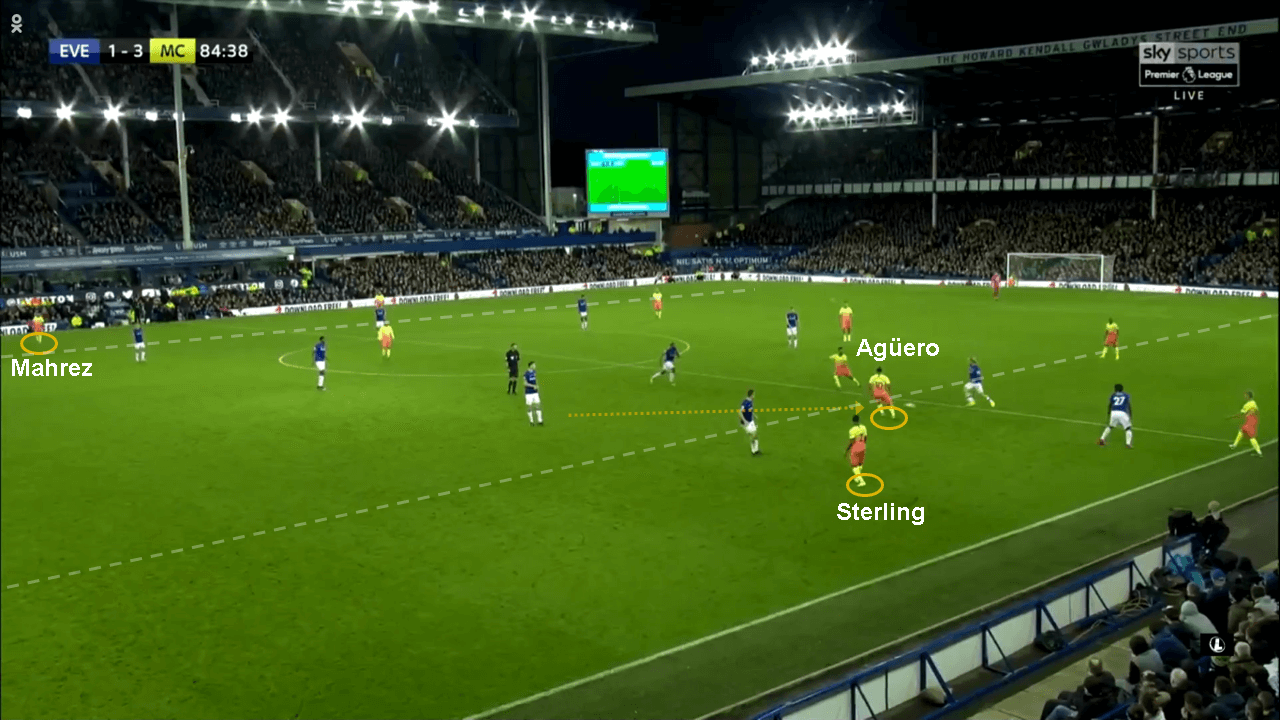
Agüero played deeper as a false-nine and engaged in quick combination passes overloading the half spaces and distributing the ball-wide or engaging in shots himself. It was him who set up the final goal for City by coming deep to receive a pass from the defensive build-up and then distribute it out wide to Mahrez who put it back into the box to find Sterling. Although Agüero did not score, he played a big role in setting up the crucial goal that gave Guardiola a sigh of relief knowing that three points were in the bag.
Conclusion
City managed to find the win in Liverpool against Everton, but it was certainly hard-fought and no walk in Goodison Park. Everton looked very threatening and times and Marco Silva’s strategy to stop City might even have been successful had it not been for Ederson to save the day between the sticks.
De Bruyne was brought off as he looked to pick up a minor injury. With City’s central defenders also injured, this could be a matter of concern for Guardiola before the Champions League fixture. Although Fernandinho does manage a commendable job as a centre half, it is more of a plan B which brings success against weaker sides where City spend more time building up than defending. But the real absence of an experienced central defender continues to haunt Guardiola as the margins are finer than the previous season in both the English Premier League and the Champions League.

If you love tactical analysis, then you’ll love the digital magazines from totalfootballanalysis.com – a guaranteed 100+ pages of pure tactical analysis covering topics from the Premier League, Serie A, La Liga, Bundesliga and many, many more. Buy your copy of the September issue for just ₤4.99 here





Comments